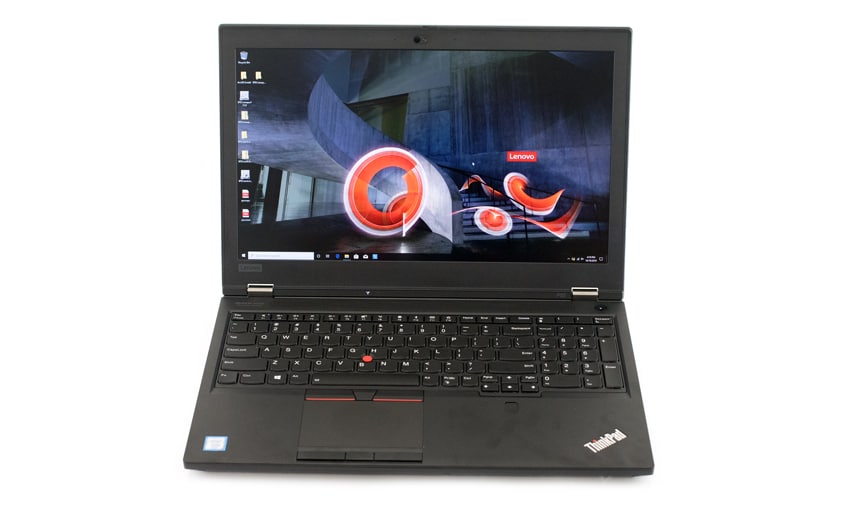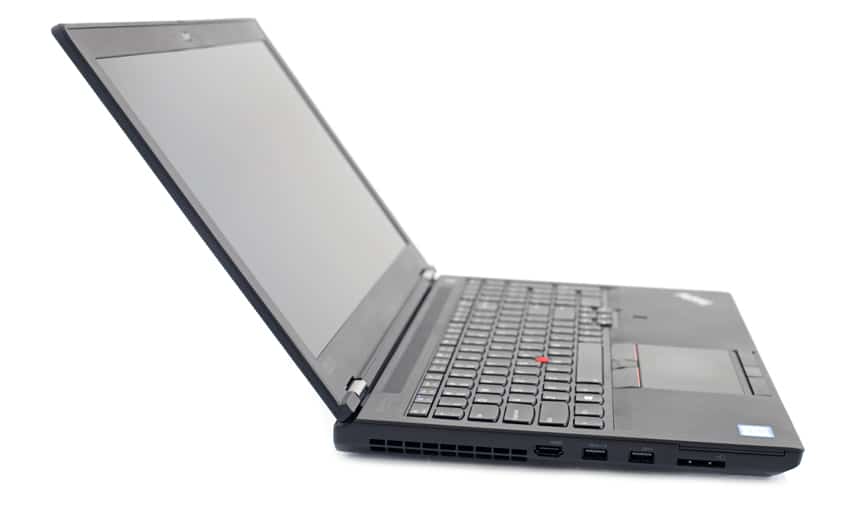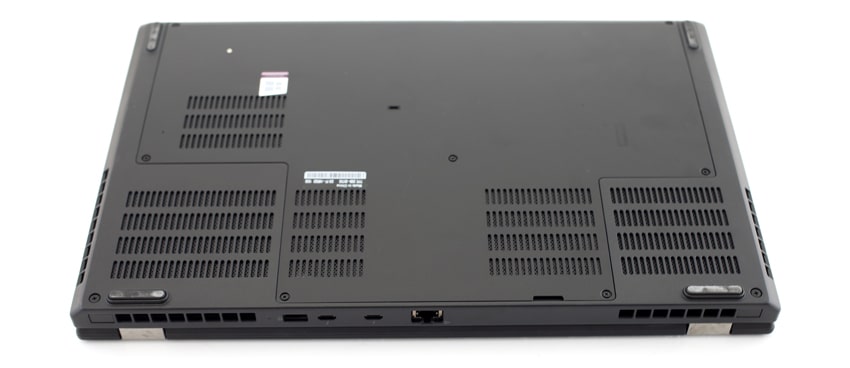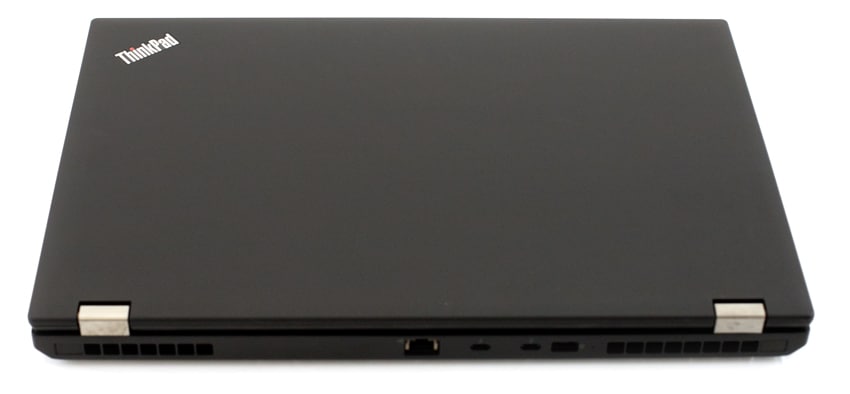
Lenovo launched the next generation of its ThinkPad P Series portfolio in June, unveiling, amongst other units, the ThinkPad P53. With the release of the new NVIDIA Quadro GPUs a wave of highly-powerful laptops have been coming out featuring the innovative hardware. The ThinkPad P53 is made for engineers, architects, and designers with ISV certifications and support for work with AR, VR, and AI. In addition to being outfitted with NVIDIA Quadro GPUs up to the Quadro RTX 5000 and 9th Gen Intel Core and Xeon processors with up to 8 cores, the ThinkPad P53 also features up to 6TB PCIe NVMe SSD storage, up to 128 GB DDR4 memory, a 15” OLED Touch Display with Dolby Vision HDR, and dual Intel Thunderbolt 3.

The ThinkPad P53 is versatile and offers the ability to access workflows previously limited to larger and heavier mobile workstations and towers. With this generation Lenovo has focused on maximizing portability and power. The new workstations feature new power supplies that are slim and 35% smaller. Starting at 5.5 pounds and 24.5mm thin, the ThinkPad P53 is a happy medium that offers the best of both worlds and balances portability with powerful computing ability in a 15” form factor.
The ThinkPad P53 model that we were given to review was customized with an Intel Xeon E-2276M CPU, NVIDIA Quadro RTX 5000 GPU, 64 GB RAM, 1 TB PCIe NVMe OPAL 2.0 M.2 SSD storage, and 15.6” FHD IPS anti-glare display.
Lenovo ThinkPad P53 Specifications
| Processor Family | Intel Xeon processor (E-2276M) 9th Gen Intel Core i9 processor (I9-9880H) 9th Gen Intel Core i7 processor (I7-9750H, I7-9850H) 9th Gen Intel Core i5 processor (I5-9400H) |
| Operating System | Windows 10 Home 64 bit Windows 10 Professional 64 bit (recommended) Windows 10 Pro for Workstations 64 bit (Xeon Processor) Ubuntu Linux (pre-load) Red Hat Linux (certified) |
| Chipset | Intel CM246 chipset |
| Maximum Memory | Maximum Memory: 128 GB Type: DDR4 SDRAM ECC and Non-ECC Speed: 2666 MHz |
| Memory Slots | 4 SODIMM |
| Optane Support | Intel optane Memory M10 Intel optane Memory with SSD |
| Available Graphics | |
| Integrated | Intel UHD Graphics 630 Intel UHD Graphics P630 |
| Discrete | NVIDIA Quadro RTX 5000 16GB GDDR6 NVIDIA Quadro RTX 4000 8GB GDDR6 NVIDIA Quadro RTX 3000 6GB GDDR6 NVIDIA Quadro T2000 4 GB GDDR5 NVIDIA Quadro T1000 4 GB GDDR5 |
| Display Options | 15.6″ UHD 4K (3840 x 2160) OLED, 400 nits, multi-touch, AR/AS with Dolby Vision HDR 500, 100% DCI-P3 Color gamut 15.6″ UHD 4K (3840 x 2160) IPS, anti-glare, 500 nits, Dolby Vision HDR 400, 100% Color gamut 15.6″ FHD (1920 x 1080) IPS, anti-glare, 500 nits, Dolby Vision HDR 400, 72% Color gamut 15.6″ FHD (1920 x 1080) IPS, anti-glare, 300 nits, 72% Color gamut |
| Storage Options | M.2 PCIe-NVMe Opal Solid State Drive
2.5″ 7200RPM SATA HardDrive
2.5″ 5400RPM SATA HardDrive
|
| Maximum Storage | Up to 6TB – (2TB max for a single hard drive) Up to 3 Hard Drives |
| Raid Connectivity | RAID 0 RAID 1 RAID 5 |
| Communications | |
| WLAN | Intel Wi-Fi 6 AX200 (Gig+) + Bluetooth 5.1 vPro |
| WWAN | Wireless WAN upgradable Integrated Mobile Broadband 4G LTE-A, Fibocom L850-GL, M.2 card |
| Audio | HD Audio, Synaptic CX11880 codec / stereo speakers, 2W x 2 / dual array far-field microphone, headphone / microphone combo jack, Dolby Atmos sound system |
| I/O Ports and Connectors | |
| Back | 2x USB-C Thunderbolt 3 1x RJ45 Gigabit Ethernet 1x Power Connector |
| Left | 2x USB-A 3.1 Gen 1, 1 Always on 1x HDMI 2.0 1x Smart Card Reader |
| Right | 1x USB-C 1x Mic/Headphone Combo Jack |
| Physical | |
| Dimensions | Width: 14.86″ (377.4mm) Depth: 9.93″ (252.3mm) Height: 0.96-1.16″ (24.5-29.4mm) |
| Weight | Starting at 5.51 lbs (2.5 kg) |
| Power | |
| Battery | 90WHr |
| Power Supply | 170W Slim 230W Slim |
Design and Build
The design of the P53 features the classic brand hallmark of an all black chassis, silver hinges, and a dash of red on the mouse. It fits in with brand aesthetic and is recognizable as so. As far as workstations go the 15 inch form factor has many benefits. This form factor is slim, fits comfortably in most bags, and the display is a reasonable size even for detail oriented work.
Getting into the nitty gritty of the chassis, the majority of the connectors are on the left side and back of this computer. On the left side there are 2x USB 3.1 ports, 1x HDMI, 1x SD card reader. The back features 2x USB-C Thunderbolt 3, 1x power connector, and 1x RJ45. The right side features 1x headset/mic jack, 1x USB-C, and a lock slot.
Shattering boundaries, boosting graphics power, and improving capability the NVIDIA Quadro RTX professional GPUs are an impressive option available on the ThinkPad P53. The new Quadros are the first to incorporate ray-tracing and tensor (for AI acceleration) cores, differentiating them from their Pascal predecessors. Below are the specs on all GPUs available for the ThinkPad P53.
NVIDIA Quadro RTX 5000 Specifications:
- GPU Architecture: NVIDIA Turing
- Single-Precision Performance: Up to 9.4 TFLOPS
- Tensor Performance: Up to 75.2 TFLOPS
- NVIDIA Cuda Cores: 3,072
- NVIDIA RT Cores: 48
- Tensor Cores: 384
- Memory Configuration: 16GB GDDR6
- Memory Bandwidth: Up to 448 GB/s
- Display Output Connectors: 4x DisplayPort 1.4, 1x USB-C
- Board Form Factor and Length: 4.4” H x 10.5” L, Dual Slot, Full Height
- Thermal Solution: Active
- Max Power Consumption: 80 – 110 W
- VR Ready: Yes
NVIDIA Quadro RTX 4000 Specifications:
- GPU Architecture: NVIDIA Turing
- Single-Precision Performance: Up to 8 TFLOPS
- Tensor Performance: Up to 63.9 TFLOPS
- NVIDIA Cuda Cores: 2,560
- NVIDIA RT Cores: 40
- Tensor Cores: 320
- Memory Configuration: 8GB GDDR6
- Memory Bandwidth: Up to 448 GB/s
- Display Output Connectors: 3x DisplayPort 1.4
- Board Form Factor and Length: 4.4” H x 9.5” L, Single Slot
- Thermal Solution: Active
- Max Power Consumption: 80 – 110 W
- VR Ready: Yes
*NVIDIA Quadro RTX 3000 Specifications:
- GPU Architecture: NVIDIA Turing
- Single-Precision Performance: Up to 5.4 TFLOPS
- Tensor Performance: Up to 42.9 TFLOPS
- NVIDIA Cuda Cores: 1,920
- NVIDIA RT Cores: 30
- Tensor Cores: 240
- Memory Configuration: 8GB GDDR6
- Memory Bandwidth: Up to 336 GB/s
- Display Output Connectors: DisplayPort 1.4
- Board Form Factor and Length: x
- Thermal Solution: Active
- Max Power Consumption: 60 – 80 W
- VR Ready: Yes
*NVIDIA Quadro T2000 Specifications:
- GPU Architecture: NVIDIA Turing
- Single-Precision Performance: Up to 3.5 TFLOPS
- NVIDIA Cuda Cores: 1,024
- Memory Configuration: 4GB GDDR5
- Memory Bandwidth: Up to 128 GB/s
- Display Output Connectors: DisplayPort 1.4
- Board Form Factor and Length: x
- Thermal Solution: Active
- Max Power Consumption: 40 – 60 W
- VR Ready: No
*NVIDIA Quadro T1000 Specifications:
- GPU Architecture: NVIDIA Turing
- Single-Precision Performance: Up to 2.6TFLOPS
- NVIDIA Cuda Cores: 768
- Memory Configuration: 4GB GDDR5
- Memory Bandwidth: Up to 128 GB/s
- Display Output Connectors: DisplayPort 1.4
- Board Form Factor and Length: x
- Thermal Solution: Active
- Max Power Consumption: 40 – 50 W
- VR Ready: No
**Specifications based on most recent data sheets from NVIDIA and AMD.
*No datasheet for the NVIDIA Quadro RTX 3000, T2000, or T1000 were available. Information was taken from the Quadro mobile line card published in August of 2019.
Performance
We put the Lenovo ThinkPad P53 through three resource intensive tests to see what it can do as well as test the capabilities of the Nvidia Quadro RTX 5000. In this testing we will be comparing it to the ThinkPad P72. This first test is the SPECviewperf 13 benchmark, which is the worldwide standard for measuring graphics performance based on professional applications. SPECviewperf runs 9 benchmarks called “viewsets,” which represent graphics content and behavior from actual applications and include categories such as 3D Max, CATIA, Creo, Energy, Maya, Medical, Showcase, Siemens NX, and Solidworks.
| SPECviewperf 13 | ||
|---|---|---|
| Viewsets | ThinkPad P53 | ThinkPad P72 |
| 3dsmax-06 | 100.26 | 153.14 |
| Catia-05 | 270.88 | 252.76 |
| Creo-02 | 270.07 | 222.95 |
| Energy-02 | 38.01 | 35.65 |
| Maya-05 | 280.62 | 232.12 |
| Medical-02 | 91.97 | 55.51 |
| Showcase-02 | 95.66 | 70.38 |
| Snx-03 | 615.52 | 344.37 |
| Sw-04 | 165.60 | 134.04 |
The ThinkPad P53 beat out the competition and put up the best score in 2/3 of the SPECviewperf tests. The only category it lagged behind in was 3dsmax-06, scoring within close range of the others in Showcase-02 and Energy-02.
Next we ran SPECworkstation3, a test that specializes in benchmarks designed for testing all key aspects of workstation performance; it uses over 30 workloads to test CPU, graphics, I/O, and memory bandwidth. The workloads fall into broader categories such as Media and Entertainment, Financial Services, Product Development, Energy, Life Sciences, and General Operations. We are going to list the broad-category results for each, as opposed to the individual workloads. The results are an average of all the individual workloads in each category.
| SPECworkstation3 | ||
|---|---|---|
| Category | ThinkPad P53 | ThinkPad P72 |
| M&E | 2.00 | 1.93 |
| ProdDev | 2.21 | 1.82 |
| LifeSci | 1.76 | 1.61 |
| Energy | 1.27 | 1.61 |
| FSI | 1.59 | 1.58 |
| GeneralOps | 1.96 | 1.46 |
| GPU Compute | 3.37 | 2.53 |
SPECworkstation3 results showed the ThinkPad P53 produced scores that rank it first in every category. The ThinkPad P72 overall came in last producing the lowest scores of the bunch.
The last of the tests is the Environmental Systems Research Institute (Esri) benchmark. Esri is a supplier of Geographic Information System (GIS) software. Esri’s Performance Team designed their PerfTool add-in scripts to automatically launch the ArcGIS Pro. This application uses a “ZoomToBookmarks” function to browse various predefined bookmarks and create a log file with all the key data points required to predict the user experience. The script automatically loops the bookmarks three times to account for caching (memory and disk cache). In other words, this benchmark simulates heavy graphical use that one might see through Esri’s ArcGIS Pro software.
The tests consist of three main datasets. Two are 3-D city views of Philadelphia, PA and Montreal, QC. These city views contain textured 3-D multipatch buildings draped on a terrain model and draped aerial images. The third dataset is a 2-D map view of the Portland, OR region. This data contains detailed information for roads, land use parcels, parks and schools, rivers, lakes, and hill shaded terrain.
Looking at drawtime of the Montreal model, the Lenovo ThinkPad P53 showed an average drawtime of 00:01:30.152, while average and minimum FPS showed 569.44 and 228.08.
| ESRI ArcGIS Pro 2.3 Montreal | |
|---|---|
| Drawtime | Average |
| ThinkPad P53 | 00:01:30.152 |
| ThinkPad P72 | 00:01:31.638 |
| Average FPS | Average |
| ThinkPad P53 | 569.44 |
| ThinkPad P72 | 189.05 |
| Minimum FPS | Average |
| ThinkPad P53 | 228.08 |
| ThinkPad P72 | 83.02 |
Next up is our Philly model, where the ThinkPad P53 showed an average drawtime of 00:01:00.317, while average and minimum FPS showed 435.91 and 205.38.
| ESRI ArcGIS Pro 2.3 Philly | |
|---|---|
| Drawtime | Average |
| ThinkPad P53 | 00:01:00.317 |
| ThinkPad P72 | 00:01:01.079 |
| Average FPS | Average |
| ThinkPad P53 | 435.91 |
| ThinkPad P72 | 248.30 |
| Minimum FPS | Average |
| ThinkPad P53 | 205.38 |
| ThinkPad P72 | 114.32 |
Our last model is of Portland. Here, the P53 had an average drawtime of 00:00:30.395. Average FPS showed 4,246.73 while Minimum FPS showed 1,484.11.
| ESRI ArcGIS Pro 2.3 Portland | |
|---|---|
| Drawtime | Average |
| ThinkPad P53 | 00:00:30.395 |
| ThinkPad P72 | 00:00:32.196 |
| Average FPS | Average |
| ThinkPad P53 | 4,246.73 |
| ThinkPad P72 | 1,921.69 |
| Minimum FPS | Average |
| ThinkPad P53 | 1,484.11 |
| ThinkPad P72 | 763.11 |
Conclusion
The Lenovo ThinkPad P53 is a feat of engineering and design excellence wrapped up in a familiar sleek black Lenovo shell. The ThinkPad P53 isn’t the first laptop we’ve reviewed that features the power of the NVIDIA Quadro RTX 5000 with Intel 9th Gen Xeon and Core CPUs, but it is the first 15 inch form factor laptop we’ve gotten our hands on with this tech packed inside. The spec and build offers enough customization without being excessive, and offers best of class component options, including 9th Gen Intel Core and Xeon processors with up to 8 cores, a NVIDIA Quadro RTX 5000, up to 6TB PCIe NVMe SSD storage and 126GB DDR4 memory, and a 15” OLED Touch Display with Dolby Vision HDR. When outfitted with even some of these components, it is an impressive machine.
Performance results were promising for the ThinkPad P53. We compared the P53 to a beefier 17” workstation, the ThinkPad P72; however, it didn’t stack up and the difference between the hardware generations is significant. In SPECviewperf 13, the P53 performed best in a majority of the categories we tested. The only category the P53 fell behind was the 3dsmax, though it swept the rest of the board by a large margin. This trend continued with the SPECworkstation3 benchmarks (which focuses on CPU, graphics, I/O, and memory bandwidth), where the P53 handily beat out its 17-inch workstation in all categories. Looking at the Esri benchmark exposed the generational performance-gap even more, as it consistently doubled the minimum and average FPS performance over the P72, sometimes even more. For example in the Portland 2-D map benchmark, the P53 boasted an average and minimum FPS of 4,246.73 and 1,484.11, respectively, while the P72 showed 1,921.69 and 763.11.
This performance-driven ThinkPad will excel in everything that is thrown at it. Of course you will have go deep in your pockets to build the most powerful version of the P53, and many consumers and professionals will. For those who can’t, the P53 can certainly be customize it to suit a range of budgets.
Sign up for the StorageReview newsletter



